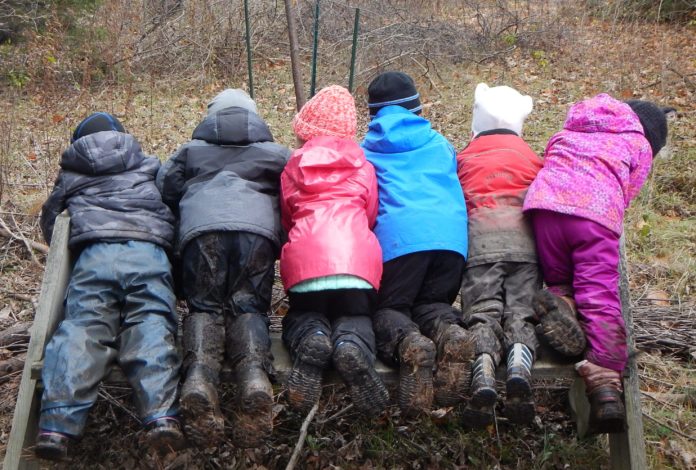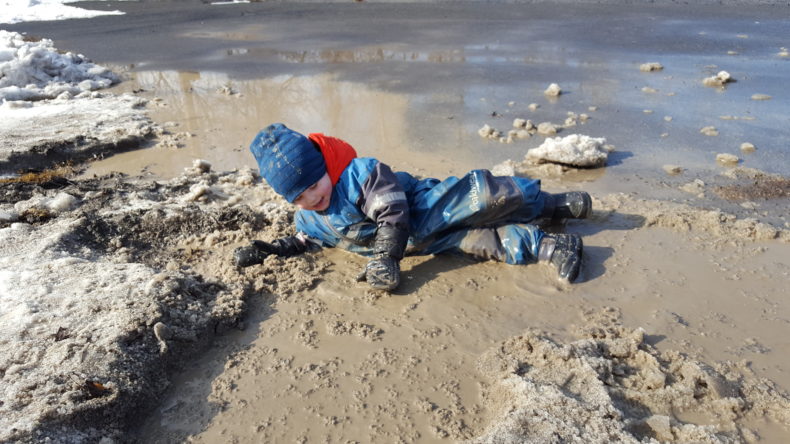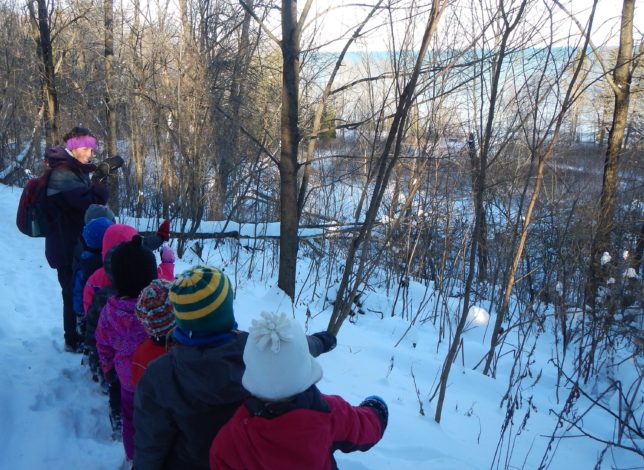Learning outside used to be the norm...
In grade school, there were two massive oak trees next to a walking path. Recess was time to sit under these providers of shade or walk the path looking up at their height. We also ventured underneath the playground and played kitchen, using our imaginations to bake different meals. While I can’t remember all of the day-to-day activities that took place in the classroom, those three times per day we were allowed outside really stuck with me. Now, as a teacher, I realize kids don’t always get the outdoors time they need while in school. And as a working parent, I sometimes feel a bit bummed seeing the daytime hikes I’m missing out on in my newsfeed. When I heard my children’s daycare/preschool was investing in an outdoor classroom, I was excited to learn more.
Nature classrooms exist to give children the opportunity to learn through outdoor play. While the looks of the classrooms may differ from school to school and state to state, the concept is the same: Get children outdoors.
The Outdoor Classroom Project
The outdoor classroom aims to have children experience nature in as many ways as possible. According to the
Outdoor Classroom Project, children have the opportunity to initiate their own learning experiences and activities, with teachers available to support them. An outdoor classroom also offers a full range of activities for children to participate in, including many that are thought to be traditionally indoor activities.
The Outdoor Classroom Project says there are many benefits to outdoor learning, including physical, psychological, and cognitive while learning to understand and appreciate nature.
Jane Pernicone, director of The Children's Center of First Baptist Church just outside of Cleveland, Ohio, referenced the article “Benefits of Connecting Children with Nature: Why Naturalize Outdoor Learning Environments” by the Natural Learning Initiative. She said that time in nature and the outdoors supports multiple development domains, supports creativity and problem solving, enhances cognitive abilities, improves academic performance, increase physical activity, improves eyesight and reduces stress.
At the
Schlitz Audubon Nature Center in Milwaukee, Wisconsin, preschool children spend between 50-75 percent of their time outdoors. Catherine Koons-Hubbard is the preschool director at the Schlitz Nature Center. She says the children's outdoor time is divided between two types of outdoor activities. Free Play takes place in an enclosed, nature-based play areas. This is followed by more structured hiking time as a group on the nature center trails,

Children learn in nature at the Schlitz Audubon Nature Center. (Photo courtesy of the Schlitz Audubon Nature Center Nature Preschool)
What does a Nature Preschool look like?
Hubbard's goals for the students during the course of the year include
- gaining a deeper sense of connection to nature
- greater social skills, including cooperative play
- problem solving and group investigations
- independence and developing greater self-assurance
- and learning to take risks/risk assessment.
"Children who can differentiate between a risk and a hazard are learning to make smart choices, rather than simply waiting to be told what to do," Koons-Hubbard said.
Schlitz Audubon's outdoor nature classroom consists of three play areas. One has a mud kitchen, with an enormous mud puddle that refills every time it rains. Another has plenty of trees and fallen logs for climbing and hiding. A third has raised garden beds, a hill with slides, and a water table. All three spaces have little wooden houses, trees, sticks, shrubs, and a special group gathering area, Koons-Hubbard said.
Classes head out on the trails after playing in the outdoor classroom, and here they participate in a variety of activities including looking for animal tracks, collecting maple sap from the sugar bush, dipping nets into ponds to look for aquatic creatures, and painting with watercolors. Koons-Hubbard said the activities the children participate in change depending on the season.
Academics still make an appearance
Although the children spend most of their day outside, they still participate in traditional math and literacy activities, but with a nature twist.
"We do not have worksheets in our program but we do make a point of introducing math, science, and early literacy concepts in a way that feels fun and organic. We study shapes in nature, and look at seasonal patterns and life cycles. We count, we identify letters, we use sticks to write in the sand or the soil, we take journals outside, as well as books," Koons-Hubbard said.
When it came time for Carrie Wenzel, Hike it Baby ambassador for the capital region of New York, to select a preschool for her son, Archer, she and her husband knew they wanted an environment that would encourage and nurture their low-tech/no-tech approach to parenting. They selected the Forest Preschool at
Waldorf School of Saratoga Springs.
"The idea of forest school is exploratory in nature to help kids discover themselves and the world," Wenzel said.

Archer enjoys time outside. (Photo courtesy of Carrie Wenzel)
Typical activities at the Waldorf School have the children sledding, climbing trees, playing in puddles, taking walks in the woods, feeding and watering the chickens, telling stories by the fire, or shoveling snow, said Wenzel.
Activities, including lunch, come full circle.
"The children help to make the bread, and then the next day they eat the bread. When the months are warm, they help plant and maintain a garden which they will eat out of as well. In the warmer months, they make grilled cheese over the open fire outside," Wenzel said.
How Can a Preschool Begin an Outdoor Program?
The
Children's Center of First Baptist Church is currently in the process of adding an outdoor classroom to its center. They had a build day in mid-June. Pieces are currently being constructed and purchased.
"Anything that can be done indoors can be done outdoors and part of the space will be adaptable for a variety of activities. Children will be able to climb and crawl, create art with items found in nature, experiment with messy materials, build with tree cookies, dig, plant, observe nature and much more," Pernicone said.
When completed, the Center will be able to take math and literacy outdoors.
"The nature classroom will be set up with interest areas just like the classroom. Plans include an art area with easel, music area with a drum and chime panel, sorting trays for loose parts, sand/water table, platform for a stage, plant scape, tree cookies and stumps, a building area, a gathering area, and a mud kitchen, Pernicone said.
Children ages 2.5-5 will be able to take advantage of the outdoor learning, with the ultimate goal being providing experiences for all children at the Center, which starts care at six weeks of age.
How Can Parents Encourage Outdoor Play?
What if your child doesn't attend a school with a nature classroom, is home during summer break, or not yet school age? Don't worry. There's plenty you can do at home!
"We believe that during the early childhood years, children learn best through play. It is far easier to provide children with opportunities for play, and to sit back and let them make discoveries, than it is to deny them these moments and then expect academic achievement," Koons-Hubbard said.
The outdoor play experience builds upon the child's development.
"All of this outdoor play not only stimulates the brain; it helps with large and fine motor development, it helps cognitive development, it helps children understand cause and effect, as well as how to make predictions and observe the results. It helps build resilience and confidence, it helps with a child’s physical well being. Finally, playing outside helps children grow up feeling connected to nature. Ask just about any adult who is passionate about conservation, the environment, or wildlife and almost all of them will tell you that their love for the natural world began by playing outside a child," Koons-Hubbard said.
Wenzel has two primary methods for parents to help get their children outdoors: Get outdoors with them in all weather conditions and unplug, unplug, unplug.
"Real human connections are important and can happen in the outdoors and because of getting outdoors," Wenzel said.

Children at the Schlitz Audubon Nature Preschool take a winter hike overlooking Lake Michigan. (Photo courtesy of Schlitz Audubon Nature Center Nature Preschool)
Catherine Koons-Hubbard's Suggestions for Outdoor Learning
These are easy ideas to implement in your home. Don't be afraid to get messy!
- Present your child with a garden plot, a shovel, and a watering can. They will learn.
- Give them an area full of sticks, pinecones, tree blocks, acorn caps, raffia, moss, pebbles. Watch to see what they create.
- Provide them access to water. This can be a rain barrel, buckets, a fancy water table or just something you’ve pieced together using random containers – and see what they do.
- Take them outside in every season.
- Read books outside
- Let them color or paint outside
Resources Available
Are you interested in learning more about outdoor education? Check out the resources below to see how an outdoor nature classroom may benefit your child's learning environment.
Finally, do you have a nature preschool or forest school experience? Share it with us below. If your kiddo attends a preschool that you love, link it here, so that other parents can join in on the fun!
 Children learn in nature at the Schlitz Audubon Nature Center. (Photo courtesy of the Schlitz Audubon Nature Center Nature Preschool)
Children learn in nature at the Schlitz Audubon Nature Center. (Photo courtesy of the Schlitz Audubon Nature Center Nature Preschool)
 Archer enjoys time outside. (Photo courtesy of Carrie Wenzel)
Typical activities at the Waldorf School have the children sledding, climbing trees, playing in puddles, taking walks in the woods, feeding and watering the chickens, telling stories by the fire, or shoveling snow, said Wenzel.
Activities, including lunch, come full circle.
"The children help to make the bread, and then the next day they eat the bread. When the months are warm, they help plant and maintain a garden which they will eat out of as well. In the warmer months, they make grilled cheese over the open fire outside," Wenzel said.
Archer enjoys time outside. (Photo courtesy of Carrie Wenzel)
Typical activities at the Waldorf School have the children sledding, climbing trees, playing in puddles, taking walks in the woods, feeding and watering the chickens, telling stories by the fire, or shoveling snow, said Wenzel.
Activities, including lunch, come full circle.
"The children help to make the bread, and then the next day they eat the bread. When the months are warm, they help plant and maintain a garden which they will eat out of as well. In the warmer months, they make grilled cheese over the open fire outside," Wenzel said.
 Children at the Schlitz Audubon Nature Preschool take a winter hike overlooking Lake Michigan. (Photo courtesy of Schlitz Audubon Nature Center Nature Preschool)
Children at the Schlitz Audubon Nature Preschool take a winter hike overlooking Lake Michigan. (Photo courtesy of Schlitz Audubon Nature Center Nature Preschool)




Comments